Erythronium Bulbs: Enhance Your Garden Erythroniums a Stunning Cultivar
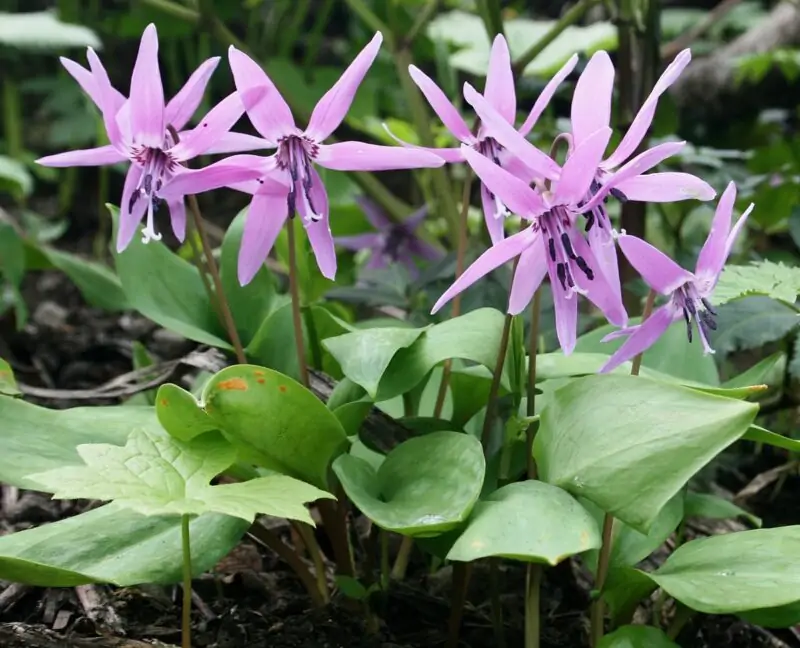
Hello to all plant lovers! This article is all about erythroniums, commonly known as dog’s tooth violets, fawn lilies, and trout lilies. If you’ve stumbled upon these wild beauties with mottled leaves and reflexed petals, you’re in for a treat. Here, we’ll explore their enchanting world, starting from their history, key features, cultivation methods, and even how you can grow them in your own garden.
Erythronium: The Dog’s Tooth Violet
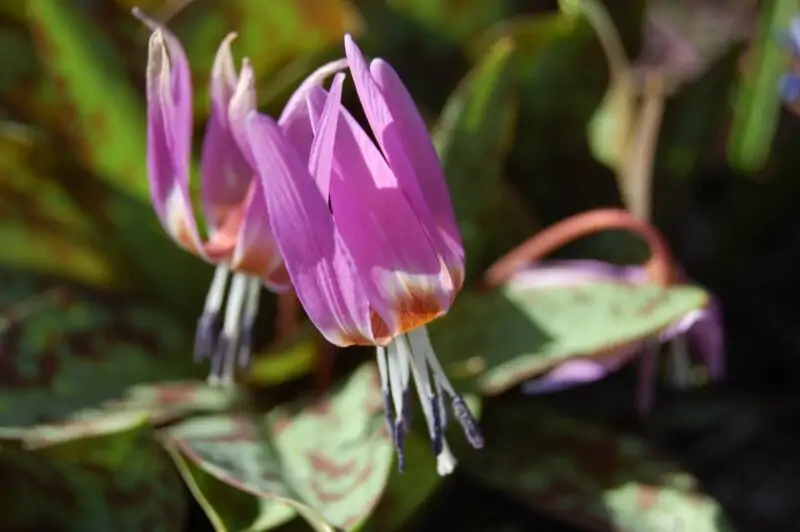
History and Background
In the vast world of perennials, erythroniums, particularly the dog’s tooth violet, have earned a special place. They trace their roots back to the forests in Europe and Asia and parts of Eastern North America. The peculiar bulb shape of these plants resembles a dog’s tooth, lending them their common name. Characterized by lily-like flowers and glossy green leaves, these beauties have become a favorite amongst gardeners and nature enthusiasts.
These flowers have a reputation for blooming with energy in the late spring. They sway with dainty, recurved petals that nod towards the ground, creating a dramatic display of maroon and lemon-yellow. Their mottled leaves add an extra dimension to their appeal, making them an exciting addition to any woodland garden.
Cultivation and Care for
These plants are surprisingly easy to grow, provided they are given the right conditions. They thrive best in soil that drains well and is rich in humus. A dappled shade under deciduous trees or shrubs is their preferred spot, where they can enjoy partial shade while growing vigorously.
These forest beauties come forth beautifully in late spring, bearing yellow flowers that seem to celebrate the arrival of warmer days. What’s more, they have a dormant phase during the dry summers, but come back even glossier next spring. And if you think these plants can’t get any better, they are also very hardy, able to withstand cold winters.
Identification and Key Features
Recognizing one is quite straightforward. Look for bright green leaves attractively mottled with maroon or brown. The flowers are another giveaway, with elegant, swept-back petals that add a touch of grace to any shady border. These flowers usually present themselves in a vivid lemon-yellow hue, but sometimes they surprise you with a rare maroon variant, adding a whimsical twist to your woodland garden.
Erythronium: The Fawn Lily
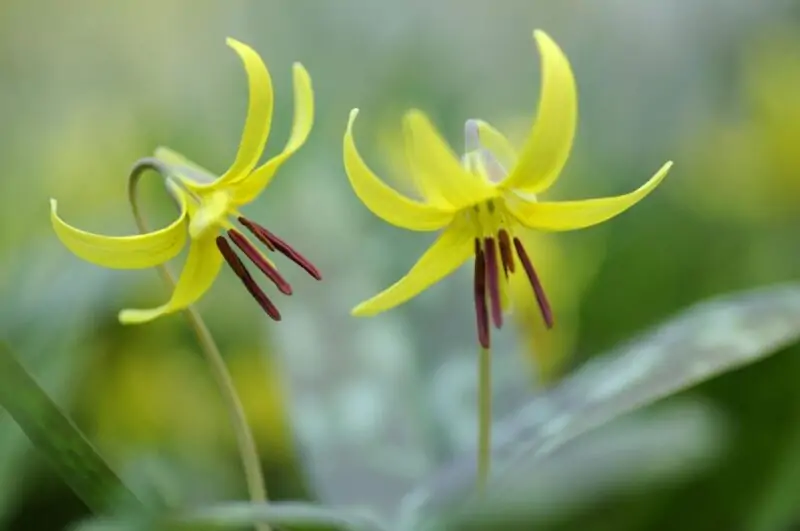
The Appeal
Moving on, we introduce another delightful member of the erythroniums family – the fawn lily. This plant derives its common name from the gorgeous mottled foliage that resembles the coat of a fawn. It stands out with reflexed white flower petals that bloom in the spring, becoming the star of any garden display.
Growing Conditions and Requirements
These flowers flourish in specific conditions. They thrive best in moist soil that’s well-drained and with partial shade. The area beneath trees or deciduous shrubs makes an excellent home for these gems, providing the right mix of shade and sun.
Plant their bulbs in humus-rich soil, add some mulch for extra nourishment, and wait for the magic to happen. Fawn lilies establish and grow quite happily, provided they’re given enough care and attention. Just like their violet cousins, they also go dormant in the hot summer months. So don’t worry if they seem to have disappeared; they’re just gathering strength for the next spring.
Recognizing and Appreciating the Beauty
Recognizing a fawn lily is an easy task, even for a gardening newbie. Their leaves are distinct, marbled with brown, similar to a young deer’s coat, hence the name ‘fawn lily’. The nodding flowers possess an appealing charm, with reflexed petals of greenish yellow that give a modest bow to the sky. In the right conditions, they expand into large clumps, providing effective ground cover. To appreciate these perennials to the fullest, it’s best to leave them undisturbed after the bloom and seed set. They are resilient and can return year after year, brightening your garden each spring.
Erythronium: The Trout Lily
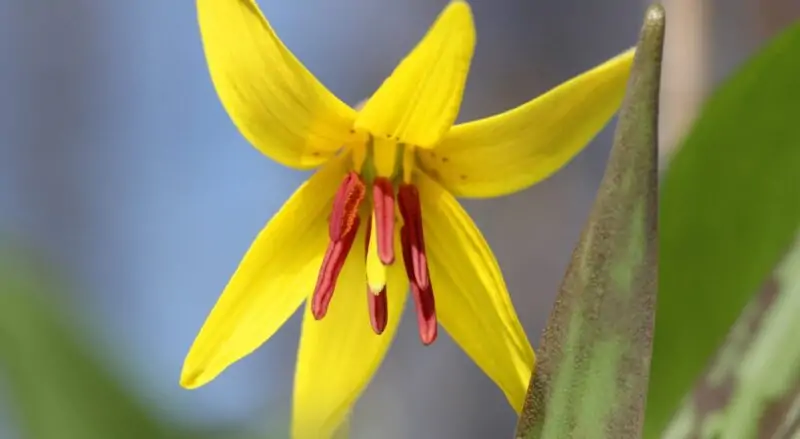
An Overview
Now, let’s turn to another charming member of the erythroniums – the trout lily. This species hails mostly from Western North America, including the lush regions of British Columbia. The trout lily gets its name from the unique pattern of the leaves, which resembles the skin of a trout. This marvelous plant greets springtime with a bow, unfurling blooms of maroon and lemon-yellow that can liven up any scene.
Proper Cultivation and Maintenance
Growing trout lilies requires an understanding of their specific needs. They favor moist but well-drained soil, laden with ample organic matter. Light levels should ideally be low, so it’s best to position them under deciduous trees or a larger shrub. This offers a dappled shade, replicating their native woodland habitat. The bulbs should be planted in autumn. With a layer of leaf mould or compost as mulch, your friends will be off to a great start.
Trouts are among those plants that flourish when left to their own devices. Once established, they require minimal care. These hardy perennials can endure even harsh winters and return with a burst of life every spring. You will witness the leaves emerge first, followed by the dainty, lily-like flowers. They go dormant for the summer, lying low under the soil surface, preparing to make a grand return the following spring.
Unique Characteristics
Trouts are not your average lilies. They stand out with a charm of their own. The maroon and lemon-yellow blooms are a sight to behold, and their leaves, mottled with a pattern that mirrors the skin of a trout, add to their unique appeal. The flowers, in their nodding posture, create a quaint, relaxing vibe in any garden space. And the glossy green leaves, even when the flowers are not in bloom, provide a pleasing green spot in your garden.
Erythronium: The Diverse Shades of Violet
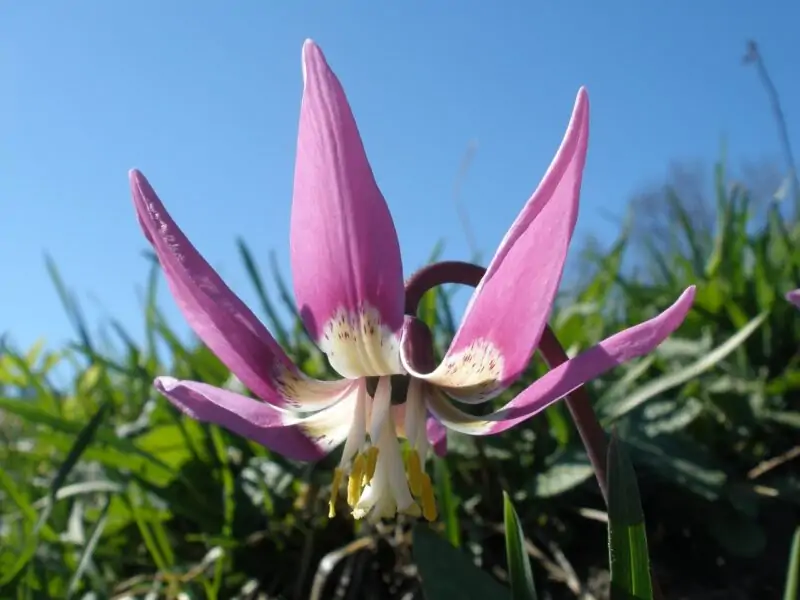
Understanding the Violet Hues
The realm of erythroniums isn’t just about the three types of blooms we’ve just seen. This versatile family also presents various hues of violet, adding a vibrant splash of color to woodland gardens. From lavender-pink to mauve-pink, the diversity is immense. Each variant has its distinct charm and beauty, contributing to the overall appeal of these plants.
Violet Erythronium Species
Violet Erythronium species, such as Erythronium ‘Pagoda’ and Erythronium californicum ‘White Beauty’, are popular among plant lovers. Erythronium ‘Pagoda’, a vigorous hybrid, boasts nodding, lily-shaped flowers with reflexed petals in a delightful shade of soft yellow, a yellow centre, and contrasting brown stamens. On the other hand, Erythronium californicum ‘white beauty’ exhibits elegant, white flowers with a hint of lavender-pink towards the center and attractive glossy green leaves. These varieties bring diversity to your garden, adding their unique charm and elegance to any shady spot.
Caring for Violet Erythroniums
Caring for these isn’t vastly different from their yellow counterparts. They thrive in moist, humus-rich soil with good drainage. These perennials are forest creatures, so they love being nestled under the dappled shade of their taller green friends, such as trees or shrubs. Regular watering is crucial during their growth phase, but you can reduce the frequency once they’ve established. A good layer of mulch provides the needed nutrients, helping them flourish beautifully. And let’s not forget: patience is key. Given the right conditions, they will reward you with a vibrant display of nodding flowers and mottled foliage every spring.
Create the Garden: Cultivating Erythroniums at Home
Preparing the Garden
Preparing your garden is the first step towards cultivating these perennial beauties. You need to create conditions similar to their natural habitat, a woodland garden. Look for a spot under deciduous trees or shrubs that provides dappled shade. The soil should be moist and well-drained, rich in humus. Mulch it with leaf mould or compost, which helps improve its fertility and structure.
Planting and Care
When it comes to planting erythroniums, timing and technique are important. Place the bulbs in autumn, about 10-15cm deep into the soil. Ensure the pointy end of the bulb faces upwards. It’s also a good idea to plant them in groups to create a naturalistic forest effect. After planting, water them regularly, especially in dry conditions.
Growing these is a journey of patience and delight. These plants might seem delicate, but they’re pretty tough. They survive winter frosts and bounce back in spring, flaunting their glossy, mottled leaves and elegantly nodding flowers. The golden rule of growing erythroniums is: don’t disturb them. Once planted, let them establish, bloom, and go dormant on their own. They will return year after year, rewarding you with their enchanting display.
Troubleshooting Common Issues
Even though erythroniums are generally robust and easy to grow, they might sometimes face issues. The bulbs might rot if the soil is too wet or poorly drained. They might fail to bloom if they are disturbed frequently or if they don’t get enough light. If you notice any problem, it’s best to assess the situation and make necessary changes to their growing conditions.
Frequently Asked Questions (FAQs)
Erythroniums prefer partial shade under deciduous trees or shrubs, well-drained, humus-rich soil, and a cool, moist environment. They’re woodland plants, so try to replicate their natural habitat.
Differentiating between these species is quite straightforward. Dog’s tooth violet has lemon-yellow flowers, fawn lily blooms with white or light yellow flowers, and trout lily features maroon and lemon-yellow blooms. Also, their leaves are distinctly mottled, helping to identify each type.
To maintain their vibrant hues, ensure your violet erythroniums get the right amount of light. Too much direct sunlight can wash out their colors, while too little may lead to faded hues. Also, providing them with nutrient-rich soil and regular watering helps keep their colors vivid.
While fairly resilient, they may be susceptible to slugs and snails. A natural way to deter these pests is to create a barrier using crushed eggshells or diatomaceous earth around the plants. As for diseases, they’re most commonly affected by bulb rot due to overly wet soil, so good drainage is key.
They can be propagated from seeds or by dividing established clumps. For the latter, wait until the plant is dormant in late summer to early autumn. Lift the clump gently, separate the bulbs, and plant them in a well-prepared site.
Conclusion
We’ve traveled through the enchanting world of erythroniums, delving into their unique species like the dog’s tooth violet, fawn lily, and trout lily, and appreciating their various shades of violet. From their captivating history to their vibrant presence in the modern garden, erythroniums are indeed a jewel in the woodland garden’s crown. They require specific growing conditions, but with a bit of patience and the right care, these perennials reward you with a fantastic display of nodding flowers and mottled foliage every spring. Their resilience and diverse beauty make them worth every minute spent on their care.